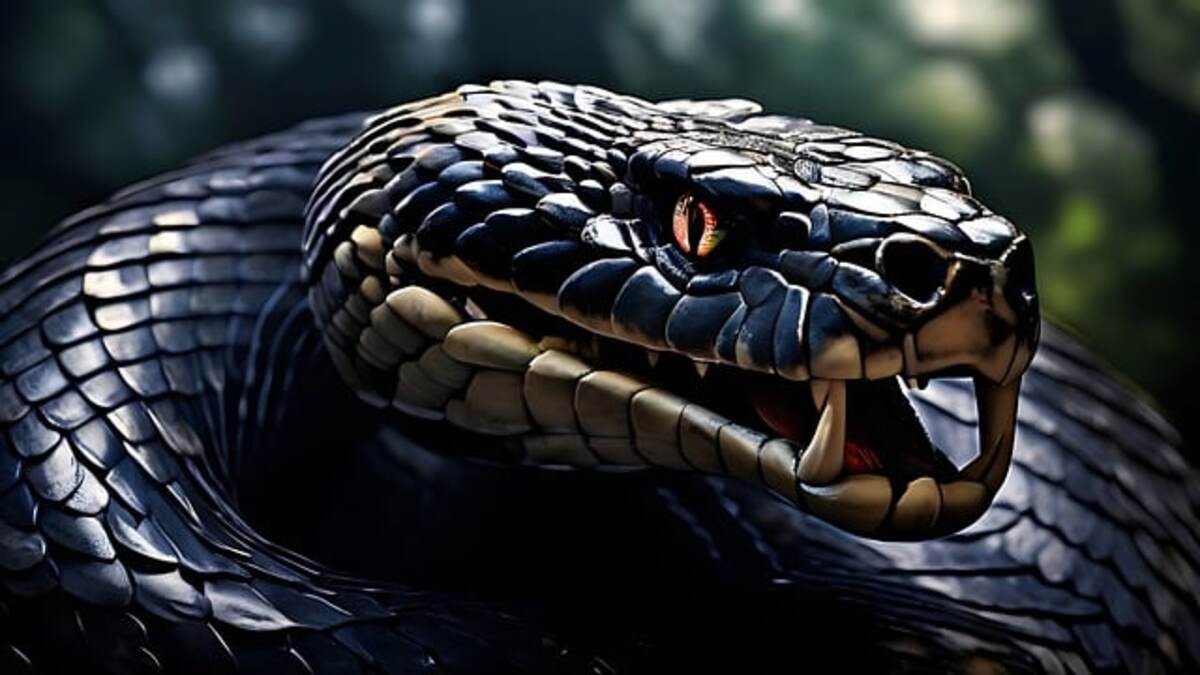Introduction and Historical Significance
What Are King Cobras?
King Cobras are among the most fascinating creatures in the animal kingdom. Known for being the longest venomous snakes in the world, King Cobras (Ophiophagus hannah) can reach lengths of up to 18 feet. These reptiles not only boast impressive physical dimensions but also possess a distinctive hood that makes them instantly recognizable. Despite their fearsome reputation, King Cobras play a crucial role in balancing ecosystems, controlling populations of other snakes and small animals alike. Their ability to adapt to various environments—from dense tropical forests to open grasslands—illustrates nature’s remarkable ingenuity. Often, the Amazing fact about the king cobra snake for sale.
When people hear “King Cobras,” images of stealth, power, and mystery come to mind. These snakes are not simply dangerous predators; they are symbols of nature’s raw force. Their presence in art, literature, and even traditional medicine underscores a dual identity: one steeped in both scientific interest and cultural lore. Many communities have long associated King Cobras with divine power or protection, believing that these creatures hold secret qualities that go beyond their biological attributes.
Bearded Dragons: The Complete Care Guide for a Calm and Captivating Reptile Pet
Bearded dragons are popular reptile household pets, cherished for their gentle dynamics, unique appearance, and content care requirements. Whether you are a first-time owner or maybe a seasoned reptile enthusiast, these kinds of charming buy german giant bearded dragons make trustworthy and fascinating companions. This thorough guide covers everything from situation setup and diet to help handling, behavior, and well-being, ensuring your bearded cavalier thrives in your care.
Historical and Cultural Perspectives
For centuries, King Cobras have captivated the human imagination. In many Asian cultures, they are more than just reptiles; they are revered beings that appear in myths, religious rituals, and folklore. Ancient carvings, temple murals, and traditional stories often depict King Cobras as guardians of sacred spaces. In India, Thailand, and Indonesia, for example, these snakes are sometimes seen as protectors against evil, and their images are used to ward off misfortune.
The arrival of European explorers in Asia further spread tales of King Cobras to the Western world. Early travelers documented encounters with these majestic snakes, often blending factual observations with embellished anecdotes. Such narratives contributed to a global mythos surrounding King Cobras, one that painted them as both awe-inspiring and deadly. This mix of fact and folklore has helped to cement their status as icons of both danger and beauty.
Mythology and Folklore
Mythology plays a big part in shaping how we view King Cobras. In many rural communities, legends portray these snakes as magical creatures endowed with supernatural abilities. Some stories even suggest that a King Cobra’s presence is a sign of good fortune or personal transformation. People recount tales where encountering a King Cobra is seen as a harbinger of change—often a signal that challenges are ahead and that one will emerge stronger.
These legends are passed down from generation to generation, blending the boundaries between myth and reality. The rich tapestry of stories not only reinforces the snake’s enigmatic reputation but also serves as a reminder of the deep connections between local cultures and their natural surroundings. Whether one is a wildlife enthusiast or simply curious about nature’s wonders, understanding the cultural significance of King Cobras offers a window into the longstanding human fascination with these powerful creatures.
Historically, the blend of reverence and caution surrounding King Cobras has led to a unique coexistence. People learned to respect these snakes by integrating them into their cultural narratives, which often emphasized both their beauty and the danger they posed. This respectful awe has inspired ongoing scientific research and conservation efforts, as communities work to preserve not only the creatures themselves but also the rich heritage associated with them.
In essence, the history and mythology of King Cobras reveal much about our relationship with nature. They remind us that even the most intimidating animals have stories that resonate on a cultural and emotional level. By appreciating the deep-rooted significance of King Cobras in human history, we also gain insight into how intertwined our lives are with the natural world. This introduction sets the stage for a deeper exploration of their biology and behavior, where science meets folklore in a tale of survival, mystery, and wonder.
Physical Characteristics and Venom Composition
Anatomy of a King Cobra
King Cobras are celebrated for their striking physical attributes, which are a product of millions of years of evolution. Their long, muscular bodies are perfectly designed for stealth and agility. One of the most eye-catching features is their hood—a dramatic display of ribs extending outward when the snake feels threatened. This hood not only serves as a visual warning but also enhances their intimidating presence. The scales on their body are smooth and glossy, providing protection and aiding in swift movement through underbrush or rocky terrain.
The head of a King Cobra is another marvel of natural design. With large, expressive eyes, these snakes can see well even in low light conditions. Their forked tongue is an essential sensory tool, allowing them to detect chemical signals in the air—a crucial advantage when tracking prey. This blend of physical prowess and sensory adaptation makes King Cobras formidable predators, capable of both ambushing and actively hunting their targets.
Unique Venom Composition
A key element that sets King Cobras apart is their venom. This potent substance is a complex mixture of neurotoxins, cytotoxins, and enzymes designed to immobilize prey quickly. The neurotoxins disrupt the transmission of nerve signals, leading to paralysis and, if untreated, fatal consequences. Meanwhile, the cytotoxins and enzymes help to break down tissue, initiating the digestive process even before the prey is fully consumed.
Some important components of King Cobra venom include:
- Neurotoxins: Block nerve signals and rapidly incapacitate prey.
- Cytotoxins: Assist in tissue breakdown, making digestion easier.
- Enzymes: Facilitate the swift spread of venom, ensuring maximum efficiency.
This carefully balanced venom composition means that even a small injection can have dramatic effects. Although the potency of King Cobra venom has earned them a fearsome reputation, it’s important to note that these snakes typically avoid human encounters and only strike when provoked.
Effects of Venom on Prey
When a King Cobra strikes, its venom acts with impressive speed. The neurotoxins interfere with normal nerve function, causing rapid paralysis. This swift incapacitation is vital for a predator that relies on stealth; by neutralizing prey almost immediately, the snake minimizes the risk of injury during the hunt. In many cases, the venom not only incapacitates but also begins breaking down tissues, making the subsequent digestion process more efficient.
Researchers have studied the effects of King Cobra venom to better understand how these toxins interact with the nervous system. This research has broadened our understanding of neurobiology and even spurred interest in developing new medical treatments. It’s a prime example of how studying nature’s most potent substances can lead to breakthroughs in science and medicine.
In summary, the physical characteristics and venom composition of King Cobras reveal an evolutionary masterpiece. Their anatomy supports a life of agility and precision, while their venom demonstrates nature’s ability to craft a tool perfectly suited for survival. These aspects, combined with the snake’s overall design, underscore why King Cobras continue to be admired and studied by both scientists and nature enthusiasts alike.
Diet, Hunting Techniques, and Prey
Preferred Prey of King Cobras
King Cobras are known as “snake-eaters”—a title that comes from their primary diet of other snakes. This specialized feeding habit gives them a unique position in the food chain. Although they sometimes consume small mammals, lizards, or birds, their main preference remains other reptiles. Their choice of prey reflects their adaptability and their role in maintaining ecological balance, as they help regulate the populations of other snake species.
In addition to their penchant for snakes, King Cobras exhibit remarkable selectivity when hunting. Their ability to detect chemical cues through their forked tongue enables them to home in on specific prey. This finely tuned sense of smell is crucial when hunting in dense foliage or under the cover of darkness, ensuring that nothing escapes their notice.
Hunting and Feeding Strategies
King Cobras are patient hunters that rely heavily on ambush tactics. They often lie motionless in areas where prey is likely to pass by, waiting for the perfect moment to strike. This stealthy approach minimizes energy expenditure and reduces the risk of detection. When a potential meal comes within range, the snake strikes rapidly, injecting its venom to quickly subdue the target.
Sometimes, King Cobras adopt a more active hunting strategy, especially during cooler parts of the day when their prey might be less vigilant. Their dual approach—alternating between patience and active pursuit—demonstrates a highly refined hunting method that has evolved. Once the prey is bitten and rendered immobile, the snake begins the feeding process. The venom not only incapacitates but also pre-digests the prey, ensuring that the nutritional benefits are maximized with minimal effort.
Adaptations for Predation
The success of King Cobras in hunting is largely due to their evolutionary adaptations. Their physical build, including a long, flexible body and a powerful muscular structure, enables them to strike with both speed and precision. Their skin patterns and coloration provide effective camouflage, allowing them to blend into various environments—whether among the leaves of a forest floor or the shadows of rocky outcrops.
Moreover, behavioral adaptations further enhance their predatory capabilities. King Cobras exhibit a keen sense of awareness and are known to use their surroundings strategically. They choose ambush sites where they are both concealed and able to monitor potential prey. This careful selection of hunting spots, combined with their remarkable sensory abilities, makes them among the most effective predators in their habitat.
The overall strategy is a blend of patience, precision, and powerful physicality. Their intermittent hunting style not only conserves energy but also minimizes risk, as they avoid prolonged exposure in dangerous environments. This balanced approach is one reason why King Cobras have thrived in diverse ecosystems, from dense jungles to open rural areas.
In essence, the diet and hunting techniques of King Cobras illustrate a masterful combination of biological innovation and behavioral finesse. Their specialized feeding habits, combined with keen sensory adaptations and physical prowess, allow them to maintain their status as top predators in their ecosystems. Whether lying in wait for an ambush or actively pursuing prey, these snakes display an astonishing level of efficiency that continues to intrigue researchers and nature lovers alike.
Predators, Habitat, and Reproduction
Natural Predators and Threats
Even though King Cobras are apex predators, they are not completely free from threats. In the wild, the young and smaller individuals may fall prey to larger birds of prey—such as eagles and hawks—or even mammals that specialize in hunting reptiles. While adult King Cobras rarely encounter these dangers thanks to their size and venom, their eggs and hatchlings are particularly vulnerable.
Apart from natural predation, King Cobras face significant challenges from human activity. Habitat destruction due to deforestation, urban expansion, and agricultural development poses a serious risk. Such environmental pressures not only shrink the safe havens where these snakes live but also disrupt the delicate balance of the ecosystems that support them.
To cope with these challenges, King Cobras rely on a combination of camouflage, agility, and intimidation. Their patterned scales help them blend seamlessly into the forest floor, while the distinctive hood display serves as a deterrent to potential attackers. These adaptations, honed over countless generations, are critical for their survival in a world where both natural predators and human-induced threats persist.
Habitat and Geographic Distribution
King Cobras are primarily native to South and Southeast Asia, where they inhabit a range of environments—from dense tropical forests to open grasslands and wetlands. Their natural habitats are characterized by warm, humid climates that support a rich diversity of flora and fauna. These regions provide ample opportunities for the snakes to hunt, hide, and breed.
The geographic distribution of King Cobras is influenced by various factors, including climate stability, the presence of suitable prey, and the degree of human encroachment. In regions where natural habitats are preserved, King Cobras flourish. However, increasing urbanization and deforestation have led to habitat fragmentation, making it harder for these reptiles to find safe and undisturbed territories.
A summary of their key habitats is presented in the table below:
| Habitat Type | Characteristics | Regions |
| Tropical Forests | Dense vegetation, high humidity | Rainforests in India, Thailand |
| Grasslands | Open spaces with scattered trees | Rural areas across Southeast Asia |
| Wetlands | Water-rich environments, diverse ecosystems | Swamps and marshes in Indonesia |
| Agricultural Areas | Mixed landscapes with human influence | Edges of forested regions |
Reproductive Behavior and Lifecycle
King Cobras have a fascinating reproductive strategy that sets them apart from many other snake species. Unlike most reptiles, female King Cobras construct nests using leaves and natural debris to protect their eggs. This behavior is quite rare among snakes and highlights a remarkable aspect of parental care. Once the eggs are laid, the female typically remains nearby to guard them until hatching, ensuring that potential predators are kept at bay.
The incubation period varies depending on environmental factors like temperature and humidity, but generally, the eggs take several weeks to hatch. When the young—often referred to as snakelets—emerge, they are surprisingly independent. However, the early stages of life are perilous, and many snakelets fall prey to predators or environmental hazards. Those that survive grow quickly, aided by a high-energy metabolism that is typical of this species.
In essence, the lifecycle of King Cobras is a delicate dance of survival. Their reproductive behavior, which includes active nest protection and strategic site selection, plays a crucial role in the continuation of their populations. The slow reproductive rate, however, means that any significant loss due to habitat destruction or poaching can have long-lasting effects on their numbers.
Conservation Efforts, FAQs, and Conclusion
Conservation Status and Human Impact
Today, King Cobras face mounting pressures from habitat loss, poaching, and the illegal wildlife trade. As human activities encroach further into natural areas, the once vast territories these snakes roamed are shrinking. Deforestation and land conversion for agriculture have resulted in fragmented habitats, leaving King Cobras with fewer safe spaces to live and breed. This encroachment not only affects their population but also disrupts the ecosystems that depend on their predatory role.
Efforts to conserve King Cobras are ongoing. Wildlife organizations and governments across Asia are establishing protected areas and wildlife corridors to safeguard critical habitats. Legal measures are being enforced more strictly to combat poaching and the illegal pet trade. Moreover, educational initiatives are underway to inform local communities about the ecological importance of King Cobras, thereby reducing the fear and misunderstanding that often leads to unnecessary killing of these animals.
Some key conservation strategies include:
- Habitat Protection: Designating national parks and reserves to ensure safe living areas.
- Stricter Enforcement: Implementing tougher laws against poaching and the wildlife trade.
- Community Outreach: Educating locals on the benefits of preserving native species.
- Ongoing Research: Monitoring King Cobra populations to assess the health of their ecosystems.
For further details on these initiatives, visit National Geographic – King Cobra.
Frequently Asked Questions
Q1: What makes King Cobras different from other snakes?
A1: King Cobras are unique due to their large size, distinct hood, and highly potent venom. They are the longest venomous snakes and specialize in preying on other snakes.
Q2: Are King Cobras dangerous to humans?
A2: While their venom is extremely potent, King Cobras generally avoid human contact and only attack when threatened. Caution and respect are advised when encountering them.
Q3: What is the primary diet of King Cobras?
A3: Their diet mainly consists of other snakes, which is why they are often called “snake-eaters.” They sometimes eat small mammals, lizards, and birds as well.
Q4: How do King Cobras reproduce?
A4: Unlike most snakes, female King Cobras build nests and guard their eggs until hatching, providing a level of parental care that is rare among reptiles.
Q5: What are the biggest threats to King Cobras today?
A5: The most pressing threats include habitat loss, deforestation, and illegal poaching. Human encroachment has significantly reduced their natural habitats.
Q6: How can people help in the conservation of King Cobras?
A6: Supporting wildlife conservation organizations, advocating for stronger legal protections, and educating others about their ecological importance are effective ways to help.
Final Thoughts and Conclusion
In wrapping up our in-depth look at King Cobras, it’s clear that these majestic reptiles are much more than fearsome predators. They are integral to the balance of their ecosystems and carry centuries of cultural significance. Their fascinating biology—from their awe-inspiring anatomy and lethal venom to their specialized hunting techniques—illustrates nature’s unmatched ability to adapt and survive.
The challenges King Cobras face today, particularly from human-induced habitat destruction and poaching, remind us of the urgent need for conservation. Protecting these snakes means preserving an entire web of life that relies on their presence. By raising awareness and supporting effective conservation measures, we can help ensure that King Cobras continue to thrive in the wild for generations to come.
We hope this article has provided you with valuable insights into the world of King Cobras. From their historical and cultural roots to their modern-day struggles, every aspect of their existence is a testament to nature’s resilience and complexity. Remember, understanding these magnificent creatures not only deepens our respect for wildlife but also inspires us to take action to protect our planet’s biodiversity.
Thank you for joining us on this comprehensive journey. Stay curious, stay informed, and let’s work together to create a future where both humans and King Cobras can coexist in a balanced, thriving ecosystem.


